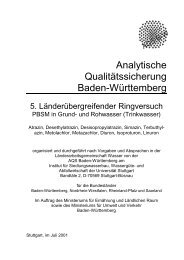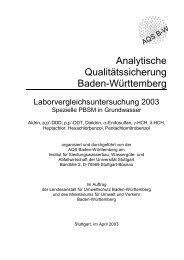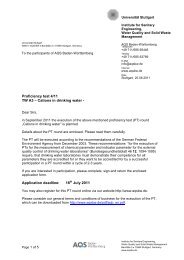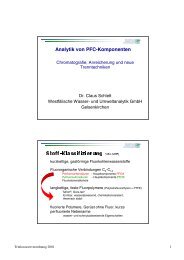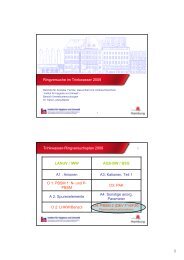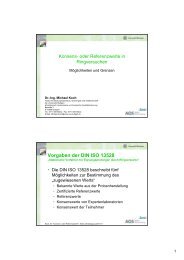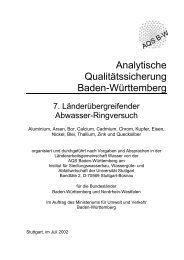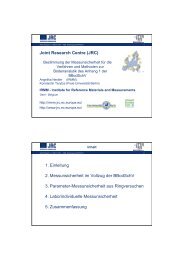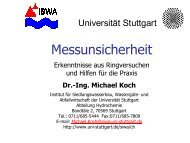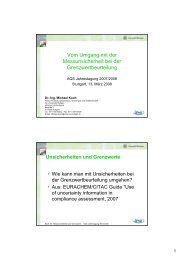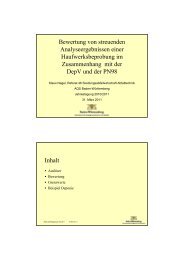Institute for Sanitary Engineering, Water Quality and Solid Waste ...
Institute for Sanitary Engineering, Water Quality and Solid Waste ...
Institute for Sanitary Engineering, Water Quality and Solid Waste ...
Create successful ePaper yourself
Turn your PDF publications into a flip-book with our unique Google optimized e-Paper software.
Urban Drainage SE<br />
Karl-Imhoff-Prize<br />
In 2009, Ulrich Dittmer from the Chair <strong>for</strong> <strong>Sanitary</strong><br />
<strong>Engineering</strong> <strong>and</strong> <strong>Water</strong> Recycling was<br />
awarded the Karl-Imhoff-Prize of the DWA (German<br />
<strong>Water</strong> Association). After Professor Krauth<br />
(1971) <strong>and</strong> Professor Thomanetz (1984) he is<br />
the third scientist from ISWA to receive this renowned<br />
award.<br />
The Karl-Imhoff-Prize was established in 1965 in recognition<br />
of the outst<strong>and</strong>ing merits of Karl Imhoff. The<br />
prize has been h<strong>and</strong>ed over at the national DWA-convention<br />
in Augsburg on the 27th <strong>and</strong> 28th of October<br />
2009.<br />
Ulrich Dittmer was awarded the prize <strong>for</strong> his PhDthesis<br />
on “Retention <strong>and</strong> Trans<strong>for</strong>mation Processes of<br />
Carbon <strong>and</strong> Nitrogen Compounds in Retention Soil Filters<br />
<strong>for</strong> CSO Treatment”. Retention Soil Filters (RSF)<br />
are applied if the condition of the receiving water requires<br />
an enhanced treatment of discharges from CSO<br />
structures. In previous field studies, RSF had shown a<br />
generally high purification capacity. However, reliable<br />
prediction of the per<strong>for</strong>mance of RSF as well as further<br />
optimization of design <strong>and</strong> operation required a<br />
deeper knowledge of the internal processes. The PhDthesis<br />
addressed open questions on these processes,<br />
focussing on retention <strong>and</strong> trans<strong>for</strong>mation of organic<br />
carbonates <strong>and</strong> nitrogen compounds.<br />
The results showed that the elimination of ammonia is<br />
based on a two-step process: during infiltration ammonia<br />
is absorbed by biofilms within the filter layer.<br />
Concentrations are reduced to a background level. Nitrification<br />
of the retained nitrogen takes place during<br />
the following dry period. Nitrification activity is highest<br />
immediately after the draining of the filter layer. Long<br />
term loading <strong>and</strong> high ammonia loads can lead to a<br />
breakthrough of the inflow concentration. In a mathematical<br />
model ammonia elimination can be represented<br />
by a storage unit that is filled during infiltration<br />
due to absorption <strong>and</strong> emptied in the dry periods by<br />
nitrification.<br />
Organic carbonates – represented by COD – show a<br />
different behaviour. The particulate fraction is retained<br />
at the surface of the filter layer <strong>and</strong> oxidized during dry<br />
periods. For soluble COD compounds the filter shows<br />
an almost constant removal rate. Oxygen consumption<br />
during infiltration indicates immediate degradation.<br />
Ammonification during dry periods shows that there is<br />
also delayed degradation of organic substances that<br />
have previously been retained by absorption.<br />
The Karl-Imhoff-Prize is h<strong>and</strong>ed over by DWA-president<br />
Otto Schaaf (left)<br />
47




